| Next > |
|---|
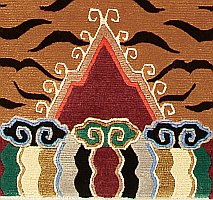 This article breaks down several myths about Tibetan rugs and tells the real story. The origins of these myths may be manifold. What was once written in books - in the meantime several decades old - has made its way into sales catalogs, and from the sales catalogs to web sites. And ever since, these myths have been repeated like Buddhist mantras.
This article breaks down several myths about Tibetan rugs and tells the real story. The origins of these myths may be manifold. What was once written in books - in the meantime several decades old - has made its way into sales catalogs, and from the sales catalogs to web sites. And ever since, these myths have been repeated like Buddhist mantras.
Read the full article and you will be astonished about all the nonsense written about Tibetan rugs.
The One-Track Mind of Western Art Experts
In my view, the major reason for myths in arts and crafts is the one-track mind of Western book writers, scholars and self-styled experts. They tend to follow two nearly religious mantras:
- Everything that was made in the past is superior to what is created now.
- Hand-made is superior to anything made with the help of machines.
Let me show you that such statements, although sometimes true, lead to wrong conclusions if applied to Asian arts, especially to Tibetan rugs.
Myth No. 1 - Tibetan Rugs are Made of Wool from Tibetan Highland Sheep
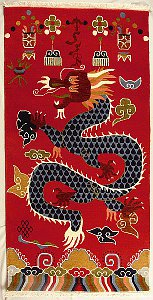 In nearly all publications and for most internet sites you will find a statement that the Tibetan rugs are made of wool coming from Tibet. They tell you that it is the best wool of the world due to the high altitude of the Tibetan plateau, and therefore the superb quality of the wool that the sheep have developed to protect themselves against the harsh environment.
In nearly all publications and for most internet sites you will find a statement that the Tibetan rugs are made of wool coming from Tibet. They tell you that it is the best wool of the world due to the high altitude of the Tibetan plateau, and therefore the superb quality of the wool that the sheep have developed to protect themselves against the harsh environment.
Sounds nice, but it is nonsense. Today the majority of Tibetan rugs is produced in Nepal, and in second place in India. The wool of the Tibetan rugs produced in Nepal comes mostly from New Zealand. The New Zealand wool is excellent. There is no problem at all. Don't worry.
Often a blend of little Tibetan and mostly New Zealand wool is used.
The import of wool from Tibet, today unfortunately a part of China, is restricted - for political reasons, for a limitation in production capacity and by a lack of a cheap transportation infrastructure between Tibet and Nepal. Thus the costs of Tibetan wool are exorbitant compared to wool imported from New Zealand. And by no means does the huge difference in price justify the miniscule difference in quality.
Myth No. 2 - Tibetan Rugs are Made by Tibetan Refugees
That's simply not true. Today most of the work in carpet factories in Nepal is done by Nepali. The simple modern designs allow to use unskilled workers.
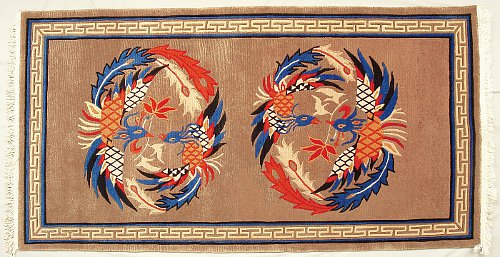
Myth No. 3 - More Knots per Inch is Better
Tibetan rugs are made in usually three (or more) different knot densities - 60, 80 or 100 knots per square inch. The difference is in the thickness of the thread. Using a thick thread of 60 or 80 knots/square inch results in a thicker tile. For a very elaborate design one must take a thin thread with 100 knots or more. But this will also result in a thinner tile.
With more knots per square inch it will take longer to produce a square meter compared to a lower density, and thus the costs are slightly higher.
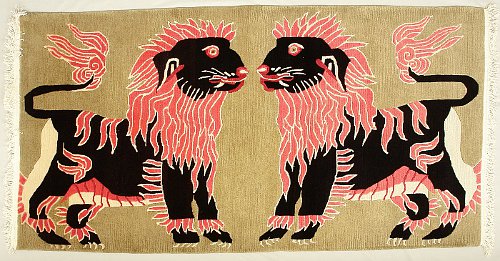
Myth No. 4 - Warp and Weft made of Wool is Better than Cotton
This is simply nonsense. The Tibetans began to replace wool for warp and weft when cotton was made available in the early 20th century. It was imported from India. Cotton is more resilient.
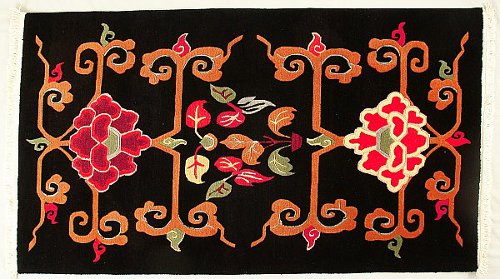
Myth No. 5 - Hand-spun Wool is Better than Machine-spun Wool
When I was in Kathmandu last time, I had the opportunity to compare two Tibetan rugs lying in front of me, side by side. One was produced with hand-spun, and the other with machine-spun wool. My Nepalese friend, carpet producer for 30 years, wanted to show me the difference. And he was right. Touching with my hand over the surface of the rug made of machine-spun wool gave me a soft feeling. The same test for the rug made from hand-spun wool gave my fingers a rough feeling. The difference was distinctive.
The manufacturing costs are nearly the same. Of course, hand-spun wool requires more work and thus provides more income to the people. But the difference in quality is obvious, and it is the contrary of what you read so often.
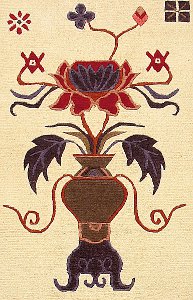
Myth No. 6 - Vegetable Dyes are Better than Chemical Dyes
Vegetable dyes are made from plants and minerals. Before the invention of the first chemical color in 1856 by William Henry Perkin, textiles could only by dyed from stuff found in nature. The disadvantages of vegetable dyes are the limited colors and the fact that the colors will fade out if exposed to light.
Chemical dyes are light-proof and allow a wide color spectrum. The Tibetans have used them since the late 19th century.
Neither vegetable dyes nor chemical dyes are better. They are just different. To get an impression what vegetable dyed rugs really look like, take a look at a slide show of roughly 50 vegetable dyed rugs with historic images from the early 1980s.
Myth No. 7 - Tibetan Rugs will get a Shiny Glimmer over the Years
You can read this again and again on web sites or in catalogs. "Due to the lanolin of the wool fiber the rug will get a shiny glimmer over the years." I have been living with all kinds of Tibetan rugs for more than 30 years. Since then my hearing ability has deteriorated, but my eyes are still OK. The above statement belongs into the category of fiction. Probably one smart guy started saying this some time ago. And two generations of carpet dealers have repeated it.
In my own observation, the vegetable dyed Tibetan rugs have become a bit dull over the years. The ones with chemical dyes have remained what they were. And none has become more 'shiny' over the years.
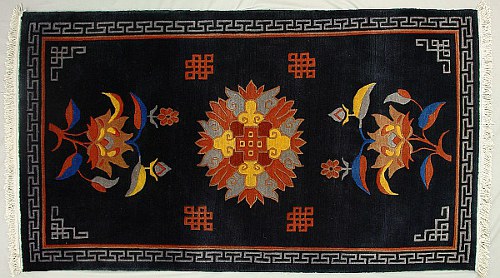
Myth No. 8 - Tibetan Rugs can be Characterized by Provenance
Persian rugs for instance are categorized by the carpet producing centers, with each having its own peculiarities. Thus one uses such names like Tabriz, Kashan or Kerman to categorize a Persian carpet.
Many of the larger carpet selling companies apply names of fantasy to their Tibetan rug "collections". This is nothing but a sales gimmick.
There has never been any specific design or other characteristics by regions or cities in Tibet. So when you read anything like 'Tibet Quandavishnu' or 'Nepal Buktapari' you are fooled with fantasy names created by marketing nutsos.
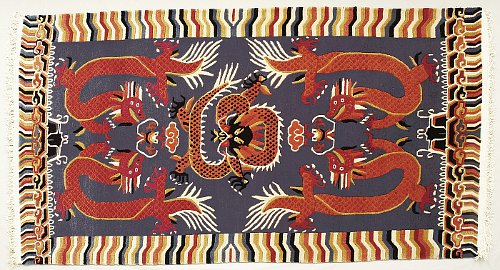
Myth No. 9 - Sizes and Designs of Tibetan Rugs
It is not really a myth. But I am sure that most buyers of a Tibetan carpet have no idea that large rugs as well as modern designs are an invention of Western designers and Nepalese and Tibetan businessmen after 1980. The Tibetans in Tibet hardly every produced any rugs larger than 3' by 6' (circa 90 by 180cm).
There were a few exceptions for monasteries and for the high-ranking nobility. But these remained a very small exception. For instance, in the private rooms formerly used by the 14th Dalai Lama at the Potala Palace you can see a few larger carpets.
The bulk of Tibetan rugs was not meant for walking on them. They were rather used to sleep or to sit on them or to wrap them around cloister pillars. Another use was as saddle rugs to protect the back of the horse and the backside of the horseman.
Today's Tibetan rug designs are completely different. Tibetan designs are elaborate, intricate and 'wild' - with dragons, lions, tigers, birds and auspicious Buddhist symbols. What you usually see on the web today as Tibetan carpets has nothing but the weaving/knotting technique in common with original Tibetan rugs.
It may nevertheless be a nice rug of high quality. And if it is a high quality product and gives an income to the people who made it, that's fine. Please buy it if you like it.
As far as artelino is concerned, we offer you only traditional Tibetan rugs in traditional designs and sizes of roughly 3' by 6' (circa 90 by 180cm).
Dieter Wanczura, October 2010.







